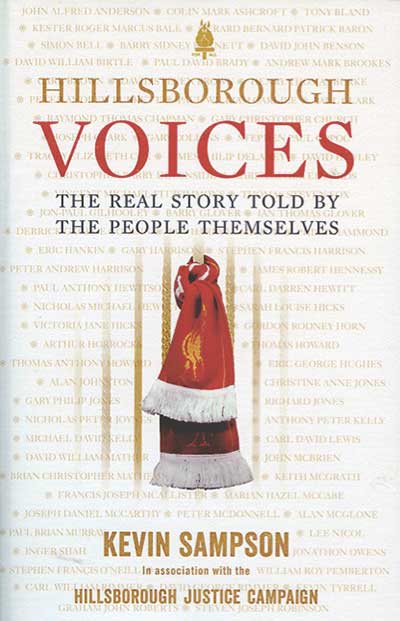 The real story told by the people themselves
The real story told by the people themselves
by Kevin Sampson
Ebury Press, £12.99
Reviewed by Rob Hughes
From WSC 353 July 2016
There are many horrific disclosures in the testimonies that make up this essential book. But perhaps the most shocking is that, of the 96 people who died at Hillsborough, as many as 58 could have survived had the correct medical procedures been in place. It’s a statistic that campaigner Sheila Coleman calls “obscene”. Compiled by Awaydays author Kevin Sampson in association with the Hillsborough Justice Campaign, Hillsborough Voices offers an unflinching account of the events of April 15, 1989 and its aftermath, from those who were there, those left bereaved and those who subsequently devoted their energies to the long struggle for truth and justice.
The first half of the book deals with the day itself and is both harrowing and profoundly affecting. It’s the story of a disaster unfolding slowly, with grim inevitability, the abject failure of officialdom in stark contrast to the small acts of heroism from those who tried to save the stricken. Pre-match, a lack of police organisation means that thousands of Liverpool fans are crammed into a restricted space outside just seven Leppings Lane turnstiles. The confusion and panic is recalled first-hand by Sampson, one of many who found themselves pinned worryingly tight against a red-brick wall.
Inside the ground, as havoc descends and supporters start spilling onto the pitch, there are recollections of lifeless bodies and supporters ferrying the injured to the medical point. Steve Hart tells of helping carry Anne Williams’ son, Kevin, on an advertising hoarding. Off-duty fireman Tony O’Keefe, stunned by the almost total absence of an emergency response, is tasked with pronouncing people dead inside the gym that serves as makeshift morgue. Damian Kavanagh, whose cries from inside pen four for officers to open the perimeter fence were routinely ignored, dismisses the idea that police froze on the day. Instead, he maintains, they were either incompetent or, worse, they just didn’t care. Seconds after discovering his dead brother under a sheet on a trolley, two coppers sit Martin Thompson down at a desk and ask if he’s been drinking. The fabricated police narrative – drunken yobs causing mayhem – was already under way. Blood alcohol levels were tested on every victim, including a ten-year-old boy.
What emerges across the next quarter century (Sampson’s interviews were conducted before the recent inquests which concluded that the 96 were unlawfully killed) is a story of grieving families and tireless campaigners being obstructed at almost every turn, yet determined to carry the fight, no matter what it takes. Hillsborough is revealed to be an institutionalised stitch-up at every level, from the Sun’s dissemination of the lie through to a private prosecution against South Yorkshire police chiefs Bernard Murray and David Duckenfield, in 2000, that ended in utter farce. It’s only in 2009, after the 20th anniversary memorial at Anfield and the government’s agreement to set up the Hillsborough Independent Panel, that the truth, as Sampson puts it, begins to be clawed back from those who sought to suppress it.
Hillsborough Voices is a testament to the courage, compassion, dignity and sheer persistence of the bereaved families, survivors and campaigners. It is often almost unbearably moving. Anyone interested in the true price of the pursuit of justice and how the establishment instinctively closes ranks, regardless of moral culpability, should read this book.